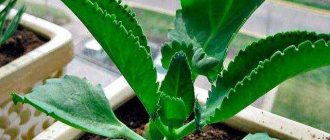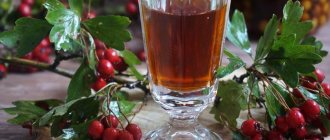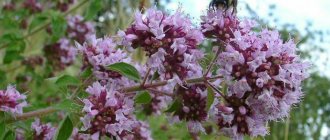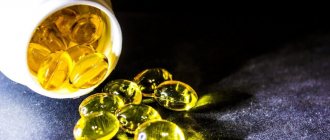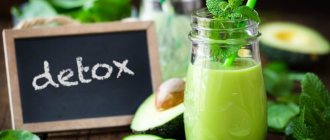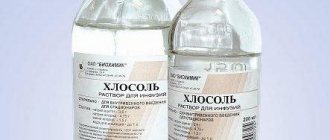Autumn is the time when viburnum ripens, the beneficial properties and uses of which we will consider in detail. The plant is known for its healing powers, and official science classifies it as a medicinal plant.
Viburnum is a large deciduous shrub or small tree. Literally translated from English, the name Cramp Bark sounds like “bark of cramps” or “bark of spasms.” It clearly speaks to the plant's ability to relieve discomfort associated with pain and PMS.
Viburnum received its Russian name because of its bright berries, reminiscent of the color of hot metal.
The shrub blooms beautifully. White inflorescences are brewed as tea for colds and added to anti-inflammatory preparations. They are used to strengthen the immune system, stabilize heart rate, and improve sleep. I wrote more about this in a separate article.
The juicy berries resemble cranberries in appearance. These are small spherical red drupes with a diameter of up to a centimeter. Inside there is a large bone, slightly flattened on the sides.
Viburnum and its bark are known for their sedative, calming, antispasmodic, and astringent properties. Let's take a closer look at this interesting plant and its many health benefits.
Beneficial properties of red viburnum
Viburnum is a plant with a rich vitamin composition, almost unique. It is precisely because of its huge chemical composition that this berry is considered a natural healer.
100 g of viburnum contains:
- 80-135 mg of vitamin C (ascorbic acid - about 2 times more than in lemon);
- 450-1350 mg of vitamin B3 (nicotinic acid, which is responsible for lowering cholesterol);
- 2.5 mg of vitamin A (carotene – a natural immunostimulant);
- 30 mg of vitamin K (has an antihemorrhagic effect);
- 0.03 mg vitamin B9 (folic acid, which lowers “bad” cholesterol);
- 2 mg/g vitamin E (tocopherol – a natural antioxidant);
- 248 mg molybdenum;
- 17 mg magnesium;
- 10 mg selenium (has the ability to accumulate);
- 0.8 mg copper;
- 6 mg manganese;
- 0.5 mg zinc;
- 0.3 mg iron;
- 0.06 chromium.
The composition also contains potassium, cobalt, and calcium.
Our ancestors believed that there was no disease for which red viburnum would not help. However, this plant is most effective for the following pathologies:
- ARVI, flu, sore throat. Viburnum is especially useful in the presence of a cold, since the plant has an anti-inflammatory, diaphoretic effect, increases the body's protective properties, and accelerates recovery.
- Pathologies of the digestive organs. It is useful to take viburnum in the form of decoctions and juices for ulcers, gastritis, inflammatory pathologies of the liver and other organs. In addition, the plant stimulates the secretion of gastric juice and has an anti-inflammatory effect.
- Diseases of blood vessels and heart. It is recommended to take viburnum decoctions for hypertension, angina, atherosclerosis, and heart pain. The plant also lowers the level of “bad” cholesterol and strengthens blood vessels.
- Pathologies of the nervous system. Taking viburnum is useful in the presence of seizures, insomnia, headaches, and neurosis. The high content of minerals and vitamins will make up for their deficiency, and by lowering blood pressure and normalizing metabolism, you can more successfully cope with diseases of the nervous system.
- Dermatological diseases. With the help of a decoction you can reduce inflammation, relieve itching and redness of the skin. Also, decoctions of these berries will help with eczema and furunculosis. Thanks to tannins and organic acids, berry decoctions destroy bacteria and speed up the healing of abrasions.
- Inflammatory pathologies of the kidneys and urinary system. Viburnum is a useful product for cystitis and pyelonephritis.
Beneficial properties of juice
Viburnum juice is an excellent helper for the body's defenses, because this drink contains several times more vitamin C than citrus fruits. It also contains other vitamins and microelements.
But an important substance in the composition is pectin. It is known for having a beneficial effect on the functioning of the intestines and cleanses it. The fruits also contain phytoncides, organic acids, and essential oils.
Thanks to this “cocktail” we can talk about the benefits of juice, which has a beneficial effect on the body: antibacterial, antipyretic, restorative. The juice also helps with hypertension - those who suffer from high blood pressure are recommended to take pure viburnum juice every day.
The drink also cleanses the vascular walls from the appearance of cholesterol plaques and has a positive effect on the entire vascular system. Juice is also an excellent natural prevention of stroke and heart pathologies.
Properties and uses of viburnum seeds
The shape of the bone resembles a heart. And this is not just like that. And all because they contain components that heal the system and strengthen the heart. However, you need to remember that they have a diuretic effect - those who have swelling should remember this.
The seeds contain a high percentage of active components. The oil obtained from the grains is used in cooking as a food additive. The oil obtained from the seeds is included in the composition of some medicinal and cosmetic preparations.
The oil is also rich in natural carotenoids. This substance will prevent the occurrence of cancer. And due to the antioxidant effect, bones slow down the aging process and protect the body from harmful factors.
With regular consumption of the stone, you can avoid the appearance of stones in the kidneys and bile duct. They will also cleanse the body of toxins.
At the same time, normalization of the functioning of the main body systems (gastrointestinal tract, intestines) will have a positive effect on appearance and general well-being. This way, headaches will go away and performance will improve. It is enough to eat 15 seeds every day to achieve a healing effect.
Some people use seeds instead of coffee. They are simply roasted in a dry frying pan, ground, then brewed like traditional coffee. The drink prepared in this way has a stimulating effect.
Viburnum leaves - properties, application
The leaves of this plant are no less useful than the rest of the viburnum. And all thanks to the many useful substances. So, they contain tannins, ursolic acid, arbutin glycoside, ascorbic acid and a lot of macroelements.
They are used fresh or dry. You can squeeze juice from fresh raw materials: just grind the leaves in a blender, squeeze the mass through cheesecloth. The resulting drink should be taken 60 ml three times a day.
According to traditional healers, this juice has a healing effect and helps relieve severe mental pain. To make the drink pleasant to taste, just add a little honey to it.
The juice can also be used externally. It has a regenerating effect, helping to more successfully fight lichen and furunculosis.
Decoctions and infusions are made from dried leaves: they will help cope with sore throats and diseases of the oral cavity. It is enough just to rinse your mouth with them to achieve a therapeutic effect. And taking such a remedy internally will be an excellent assistant in the fight against helminths. Healthy tea is also prepared from dry raw materials: it will strengthen the immune system.
What are the benefits of the plant bark?
They use not only berries and leaves, but also the bark - decoctions and tinctures prepared on its basis have an excellent healing effect due to the presence of useful elements in the composition. Thus, the bark has an antispasmodic effect. Medicines from the bark help with:
- insomnia;
- nervous disorders.
Decoctions help relieve inflammation and stop bleeding. Pharmacy preparations based on bark are very common, which help women recover faster after childbirth.
How to use it correctly?
Below are the answers to the most popular questions regarding the consumption and use of viburnum:
- Dosage. The recommended intake for fresh berries is 75 grams per day, 4-5 times a week.
- Time of receipt. Viburnum is strictly forbidden to be taken in the morning on an empty stomach (due to the possible irritating effect on the mucous membranes of the gastrointestinal tract), as well as in the evening (before bedtime, it will cause overload of the digestive system and insomnia).
- Use in cooking. Viburnum is actively used for making jams, syrups, preserves, jelly, juice and fruit drinks. The fruits, flowers, branches and leaves of viburnum are used to prepare decoctions, teas, tinctures and other medicinal drinks.
- Properties of the seeds. Viburnum fruit seeds contain many antioxidants and are used to alleviate a number of diseases of the heart and blood vessels, and urolithiasis.
- Application of oil . Viburnum oil is rich in vitamins (A and E). It reduces the risk of developing malignant tumors. It is also used to relieve gastritis and peptic ulcers (orally) or speed up wound healing (topically).
- Application of bark. Viburnum bark is commonly used to stop local bleeding (nosebleeds) and as an antimicrobial agent for inflammatory diseases of the oral cavity.
There are a number of rules that will allow you to get the maximum benefit from berries.
Is it possible to give viburnum to children?
If the child does not suffer from any special pathologies, then viburnum can be introduced into the diet from the first year. True, like any new product, viburnum is introduced gradually, starting with 0.5 tsp. per day. If your child likes the taste and there are no side effects, you can slightly increase the dosage.
It is also worth remembering that viburnum is a fairly hypoallergenic product. It can be given in small quantities even to children with allergies. At the same time, many doctors believe that consuming this berry on a regular basis can reduce the manifestation of unwanted reactions of the body.
Berries have the same effect on a child’s body as on an adult:
- increase immunity;
- help with colitis, constipation;
- relieve headaches;
- lower blood sugar levels.
You can give your child viburnum in the form of juices, prepare fruit drinks, or simply sprinkle fresh berries with sugar.
Vitamins
Viburnum fruits contain almost all known vitamins and contain various macro- and microelements.
We present the chemical composition of viburnum in the form of tables.
| Vitamin | Content in 100 grams, in milligrams | Percentage of the body's daily requirement |
| C (ascorbic acid) | 150 | 167 |
| (phylloquinone) | 0,118 | 98 |
| Beta-carotene (precursor to vitamin A) | 0,9 | 18 |
| (tocopherol) | 2 | 13,3 |
| (folic acid) | 0,031 | 7,5 |
| B5 (pantothenic acid) | 0,31 | 6,2 |
| (a nicotinic acid) | 0,9 | 4,5 |
| B2 (riboflavin) | 0,022 | 1,2 |
| A (retinol) | 0,151 | 16,8 |
| B1 (thiamine) | 0,012 | 0,8 |
| B6 (pyridoxine) | 0,01 | 0,7 |
In terms of vitamin C concentration, viburnum is one and a half times higher than the recognized favorite - lemon.
| Mineral element | Content in 100 grams, in milligrams | Percentage of the body's daily requirement |
| Molybdenum | 0,248 | 354 |
| Cobalt | 0,029 | 285 |
| Silicon | 50 | 167 |
| Iodine | 0,09 | 60 |
| Iron | 5,95 | 33 |
| Manganese | 0,52 | 26 |
| Calcium | 171 | 17 |
| Magnesium | 57 | 14,3 |
| Phosphorus | 98,5 | 12,3 |
| Copper | 0,062 | 6,2 |
| Sodium | 60 | 4,6 |
| Potassium | 109 | 4,4 |
| Sulfur | 12 | 1,2 |
| Chlorine | 21 | 0,9 |
Contraindications: what to remember?
Despite the rich vitamin composition and a lot of useful substances, you need to remember about contraindications. They must be studied before using red viburnum, so as not to worsen the health situation.
Do not use decoctions, infusions, or juices of viburnum for:
- increased blood clotting, tendency to thrombosis (since the plant acts as a coagulant);
- gout due to the high content of purines, which can cause the formation of salts in the joints (this prohibition is more relevant for men);
- urolithiasis;
- peptic ulcer of the stomach and intestines;
- increased stomach acidity (viburnum promotes the production of hydrochloric acid and bile, which can cause exacerbation of chronic diseases);
- hypotension (consumption of viburnum can cause fainting and dizziness);
- diabetes mellitus (due to the presence of invert sugar in berries);
- enuresis (due to strong diuretic properties);
- chronic pathologies during periods of exacerbation.
It is also recommended to avoid viburnum during pregnancy, since the berries contain phytohormones that are similar to female sex hormones. Their excess can cause miscarriage and the development of pathologies in the fetus.
Methods of using viburnum in cooking
Viburnum is a popular ingredient in the kitchen, because it is not only healthy, but also very tasty. First of all, they can be consumed fresh - as a treat or as an addition to morning porridge for breakfast. Moreover, you can preserve the berry harvest by simply freezing it.
But also the fruits:
- dried;
- dried;
- squeeze juice (including from seeds);
- added as a filling to pies and other baked goods;
- used for preparing fruit drinks, mousse, jelly, and other sweets.
The berry is also widely used in the preparation of alcoholic beverages. The most famous liqueur made from the fruits of the plant is Kalinovka. But adherents of a healthy lifestyle will really like viburnum tea or coffee.
Application in medicine and cosmetology
Viburnum is a unique berry. It has found application not only in the field of cooking - it is used by folk healers and famous cosmetic companies in the production of products.
In medicine
In the field of medicine, almost all parts of viburnum are used to prepare decoctions, infusions, and healthy juice. The list of diseases for which this plant is effective is quite wide:
- cold;
- dyspnea;
- vascular and heart diseases;
- headaches, including migraines;
- various female pathologies;
- skin diseases;
- oncology;
- gastrointestinal diseases.
It is also known that viburnum activates brain activity. If you include it in your diet, you can avoid problems with memory and absent-mindedness.
The plant is also the basis of vitamin drinks, which are an excellent preventative during periods of flu and colds.
In cosmetology
Viburnum has also found application in the field of cosmetology for the following reasons:
- Ascorbic acid in the berry is a natural antioxidant that fights the very first signs of skin aging. For the same reason, it can also be used on problem skin to make it look more youthful and beautiful. To do this, you just need to make a maxi based on viburnum.
- Viburnum regulates the functioning of the sebaceous glands. Using berry-based masks or lotions will eliminate signs of shine - this is a great option for oily skin.
- Viburnum is also used to whiten the face if you have freckles. age spots.
- It will help get rid of acne - viburnum has bactericidal properties.
- Viburnum is an excellent tonic. So, masks or tonics based on berries are suitable for absolutely any skin, you just need to choose additional components. And to get a simply refreshing effect, it is enough to use frozen viburnum juice.
It is also used to strengthen and stimulate hair growth - viburnum infusion is ideal for this. It can also be added to the bath if there are skin pathologies - they will help relieve inflammation and fight eczema and other skin pathologies. And if you freeze the juice and rub the cube on your face in the morning, you can reduce the number of wrinkles.
Description of the plant
The numerous (over 160 species) genus Viburnum - in Latin Viburnum from the Adoxaceae family unites flowering shrubs and woody plants.
Various types and varieties of viburnum have predominantly high frost resistance and shade tolerance. The natural range is located mainly in the northern hemisphere.
Among the cultivated varieties, common viburnum (or red) with edible fruits is popular as an ornamental and medicinal plant.
Analyzing the description of viburnum, it is noted that it is predominantly a shrub, although sometimes woody forms are found. The average height is 1.45-4.5 meters. There are individual specimens aged 50 years and older.
The culture is characterized by trunks with grayish-brown bark and yellowish-brown shoots. Opposite leaves on petioles are predominantly round or ovoid in shape.
Small flowers are united in umbrella-shaped panicles located on the tops of young branches. Viburnum blooms at the end of May and lasts 10-20 days.
The ripening spherical or oval juicy berries of rich red color are drupes. There is a large seed inside the fruit. The taste of the pulp is astringent and bitter, but after frost the pronounced bitterness disappears.
Composition, calorie content
The chemical composition of viburnum is strikingly diverse:
- Triterpenoids, essential oil, ascorbic acid, and vitamin K were found in the roots.
- The essential oil containing tannin compounds, salicin, is part of the branches of viburnum.
- Tannins were detected in the wood.
- Viburnum bark contains carbohydrates, vitamin C, pectin, essential oil, and cellulose. Contains resins, alkaloids, phytosterol, higher fatty and organic acids, tannins, myricyl alcohol. As well as saponins, coumarins, catechin, phlobafen, triterpenoids, lignin.
- Viburnum foliage contains phenols, steroids, phenol carbonic acids, catechins, and flavonoids. There are higher fatty acids, tannins, anthocyanins, iridoids, and viopuridal. Coumarins, vitamin C, alkaloids, and ursolic acid were detected.
- The seeds are rich in fatty oil (about 20%). Contains higher fatty acids.
- Carbohydrates, pectin substances, triterpenoids, phosphorus, sulfur, phenolcarboxylic, higher fatty and organic acids were found in viburnum fruits. Tannins contain about 3%. The aromatic berries contain flavonoids, potassium, calcium, magnesium, catechins, sambucin, silicon, sodium, chlorine and numerous trace elements.
- Viburnum seeds contain flavonoids, organic acids, tannins, and pectins.
- The flowers contain flavonoids and ursolic acid.
There is a wide variety of vitamins in viburnum. Thiamine (B1), riboflavin (B2), pantothenic acid (B5), pyridoxine (B6), folates (B9) were found in the juicy pulp of berries. As well as vitamins A, C, E, K.
Based on 100 g. The calorie content of viburnum is on average 26.3 kcal.
Healthy recipes
There are dozens of recipes for preparing this berry - you can prepare sweet liqueurs, healthy decoctions, or simply grind the fruits with honey or sugar.
Viburnum with honey
For medicinal purposes, whole berries that are soaked in honey are used. This mass is an excellent protection against acute respiratory viral infections and influenza, as it strengthens the immune system.
The following ingredients are needed:
- a bunch of viburnum (about 200 g);
- melted honey (about 200 ml).
There is nothing complicated in preparation: wash the berries thoroughly, dry them, then dip them in honey and leave there for 6-7 hours so that the viburnum is saturated with nectar. All that remains is to transfer the soaked berries to a separate container and dry a little.
Viburnum with sugar
Making viburnum with sugar is very simple. First you need to buy all the necessary components:
- 300 g sugar (can be replaced with honey);
- 300 g viburnum.
Step-by-step preparation:
- We wash the berries and dry them.
- Place in a saucepan and mash with a fork as thoroughly as possible to release the juice.
- Pour in 2/3 of the specified amount of sugar and mix.
- Place the mixture in a sterilized container, leaving a little space on top.
- Add the remaining sugar, close the containers and store the viburnum with sugar in a cool place.
Viburnum jam
To make jam, take the following ingredients:
- 800 g sugar;
- 200 ml water;
- 1 kg of red viburnum.
Step by step guide:
- Rinse the berries, dry them on a piece of cloth and place them in a saucepan, add clean water.
- When the mixture boils, wait 2-3 minutes. At the same time, make syrup in another container: combine water and sugar, boil until a homogeneous consistency is obtained.
- When the first bubbles appear, pour the mass of viburnum into the syrup and boil for about 30-40 minutes. Leave the jam to sit for 5 hours, then boil it again. Don’t forget – you need to stir the mixture regularly and remove the foam.
- Bring the mixture to a thick consistency and pour into sterilized jars.
Store the jam in a dark, dry place.
Bring the sweet mass to a thick state, pour into sterilized jars. Seal with dry lids. After cooling, store the product in a dark place.
Tea with viburnum
Making tea is not difficult. You will need:
- a small bunch of berries;
- a glass of boiling water;
- sugar or honey to taste.
Wash the berries, remove the inflorescences, place in a saucepan, mash with a fork and add boiling water. Wait 7-10 minutes for the drink to infuse, add honey or sugar to taste.
Additionally, you can add lemon and other citrus fruits. But to make the tea even more beneficial, you can use any fruit or herbs, depending on what effect you want to achieve:
- Ivan tea will help fight insomnia and calm the nervous system if you add viburnum to it;
- hawthorn fruits combined with berries are an excellent drink that will help fight the consequences of a stroke;
- rosehip or beak, which can be added to tea, will significantly strengthen the immune system.
Coffee with viburnum
Coffee prepared according to this recipe will be invigorating and full of vitamins. To prepare one cup of coffee you need:
- glass of water;
- 1 tsp instant coffee;
- a small bunch of viburnum (to obtain 2 tsp juice);
- 2 tsp Sahara.
Preparation:
- We wash the berries, add sugar, and crush them using a masher. Strain the resulting juice, remove the berry skins and seeds.
- Pour boiling water over the coffee, add juice and sugar to taste.
It is not recommended to drink this drink on an empty stomach - it is better after a hearty breakfast.
Viburnum syrup
To prepare healthy viburnum syrup you need the following ingredients:
- 300 g sugar;
- 300 g viburnum.
The preparation is simple:
- Rinse the berries, remove the inflorescences.
- Place the viburnum and sugar in a blender and grind everything to make a puree.
- Leave for 1-1.5 hours, stirring several times.
- Using gauze, separate the pulp from the juice.
The finished syrup is stored in the refrigerator. It needs to be poured into glass containers.
Viburnum liqueur
Ingredients needed:
- 7 kg of viburnum berries;
- 2.5 kg of sugar.
Preparation:
- Sort the berries, rinse, place in a suitable container, add sugar, tie the neck of the container with gauze, and place in a dark place for 4 days.
- When signs of fermentation appear, you need to remove the gauze and insert a special water seal (this is a rubber tube with a diameter of about 1 cm and a length of up to 40 cm). One end of the shutter is inserted into the cork, the other into a glass of water. If you miss this moment, oxygen will enter the container, which will lead to oxidation of the liqueur.
- The drink is kept in this form for about three weeks until fermentation stops. All that remains is to strain and bottle the liquor.
Viburnum liqueur
The ingredients for the liqueur are as follows:
- 1 liter of vodka;
- 1.5 kg viburnum;
- 400 ml water;
- 1.2 kg sugar.
Making the drink is simple:
- Pour boiling water over the berries, pour into a container, add 400 g of sugar. Leave in the sun for a couple of days. Add vodka and leave for another week.
- Make syrup from the remaining water and sugar, cool it to a temperature of +30 degrees, pour into a bottle, and leave for a month. All that remains is to filter the drink and pour it into separate bottles.
Viburnum tincture
To prepare the tincture according to the classic recipe, you will need a minimum of ingredients. Ingredients:
- 1 kg viburnum;
- 1 liter of high-quality vodka (you can take moonshine).
Preparation step by step:
- Prepare the berries, pour into a three-liter container, fill with vodka so that the liquid covers the viburnum by 2-3 cm.
- Close the jar with a lid and place it in a dark place to infuse for 4-5 weeks at room temperature. Shake the container once a week.
- Strain the tincture through cheesecloth. Squeeze the berries and discard.
- Pour the drink into bottles and send it for permanent storage.
The shelf life of the tincture is 3 years, the main thing is that sunlight does not fall on the container.
Viburnum decoction
To make a healing decoction, you need:
- 2 tbsp. viburnum;
- 400 ml boiling water.
It's easy to prepare:
- Mash the berries in an enamel pan.
- Pour a glass of boiling water, heat for about 15 minutes in a water bath, and judge.
- Strain, add another glass of boiled water.
You need to take 60 ml 4 times a day. This decoction is especially useful for colds, gastritis, and for normalizing blood pressure.
A decoction can also be prepared from the flowers of the plant. You need to take 1 tsp. dry mixture, pour a glass of boiling water and leave in a water bath for 20 minutes. All that remains is to judge and strain the resulting liquid.
Using a flower decoction you can fight ulcers, eczema, cuts, boils, and acne. It is enough to simply irrigate problem areas several times a day. The decoction is also taken orally: it helps with insomnia, depression ulcers, and menstrual irregularities.
Features of preparation and storage
The bark of the plant is harvested during the period of sap flow - usually the end of March or the beginning of April. The inflorescences can be collected after they are fully opened, the berries - from mid-September. And in order for the fruits to be preserved whole, they should be cut off along with the stalk.
But the most useful are considered to be viburnum, which is collected after the first frost - the berries contain a maximum of useful elements and practically no bitterness.
The harvested crop can be frozen and dried. In the first case, you just need to package them in bags and put them in the freezer. In the second - spread out in an even layer in a dry and ventilated room for at least 10-12 days. Then all that remains is to dry them at a temperature of +50 degrees, place the dry berries in linen bags.
Viburnum is an effective folk remedy. Moreover, not only the berries of the plant are useful, but also the bark, leaves, and inflorescences. However, you need to take it for treatment purposes carefully, not forgetting about contraindications.
Folk healer - viburnum bush
Viburnum viburnum has beneficial properties in such quantities that it can compete with many other gifts of nature. Even in the old days, folk healers associated the use of shrubs with great benefits. To do this, in early spring, the bark is harvested and used:
- to stop internal bleeding,
- for gastrointestinal disorders,
- for liver and kidney diseases,
- for the treatment of sclerosis and tuberculosis.
A decoction of viburnum bark has remarkable antipyretic and anti-inflammatory properties, so it is quite successfully used for colds and infectious diseases. This folk remedy calms well and reduces the risk of seizures, therefore it is widely used for various nervous disorders.
At the end of spring, viburnum bushes begin to bloom profusely and show the whole world the beauty of their snow-white tassels. These flowers not only attract the eyes of aesthetes, but also have many useful properties. A decoction prepared from flowering viburnum tassels is used for various bleeding and inflammatory processes. This remedy not only stimulates increased sweating, which is important for colds, but also improves appetite.
